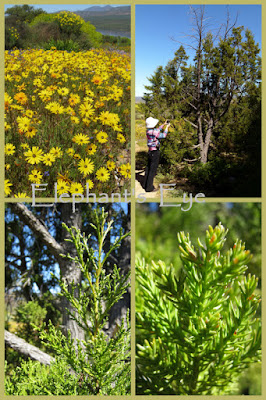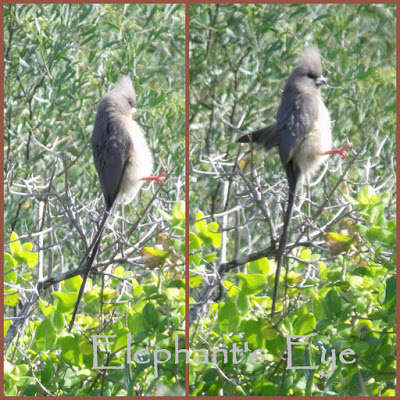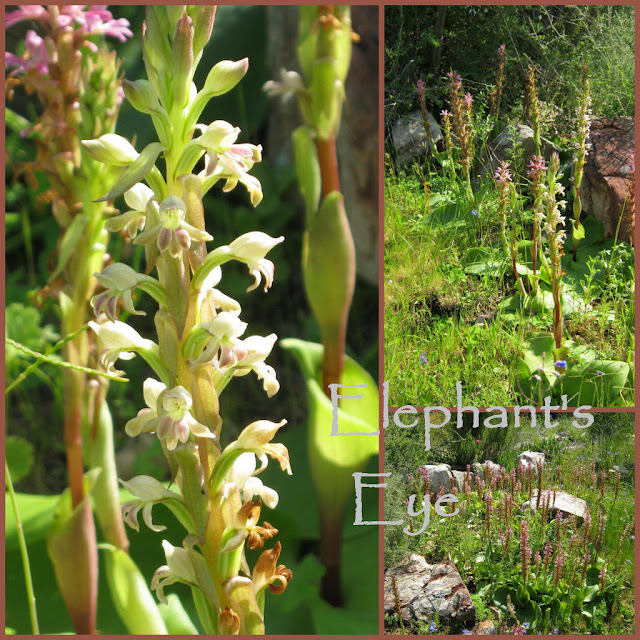Spring flowers at Ramskop
By Diana Studer
- gardening for biodiversity
in Cape Town, South Africa
 |
| At Ramskop September 2012 Sparaxis metelerkampiae, Satyrium, Euryops Geranium, Wachendorfia, Sparaxis Gladiolus, Pelargonium echinatum, Gazania |
Clanwilliam is in the Cederberg, but the cedar trees Widdringtonia cedarbergensis for which the mountains are named, battle to survive.
 |
| At Ramskop September 2012 Clanwilliam cedar |
First the flower church in Clanwilliam, and then we strolled thru the Ramskop Nature Garden in August 2010. The nature reserve was established in 1960. Cared for and nurtured by workers (from the Cederberg municipality) and volunteers. One tenth of the 66 hectares is planted. The rest is Nama Karroo, by Nature.
 |
| Daisy beetles August 2010 |
Every flower has little lives lived alongside it. Whether I try to photograph beetles and bugs or not! There are beetle daisies (Gorteria diffusa where the peacock eyes of Gazanias morph into live beetles). And daisy beetles – large, small, brown, yellow, striped, spotted or plain, pollen covered or shimmering metallic.
 |
| Whitebacked mousebirds |
Two whitebacked mousebirds. In our Porterville fig trees we had redfaced mousebirds and I'm planning and adding berry trees to encourage them to our new False Bay garden.
North of Clanwilliam is Nieuwoudtville (and the Hantam NBG), the Bulb Capital of the world. Everywhere, fynbos on the mountain slopes, on sand drifts nearer the sea, in fields and damp hollows – we have bulbs.
 |
| Gladiolus caryophyllaceus and Gladiolus venustus August 2010 |
 |
| Ramskop bulbs August 2010 |
Top left a low yellow Oxalis, green and white striped Albuca. Top right Sparaxis? Bottom delicate white Chlorophytum (related to your Hen-and-chickens or spider plant) and 2 Lachenalias, namaquensis with the colour-coded mauve stem.
 |
| Prickles and fluff August 2010 |
Left Berkheya fruticosa with slender petals and ‘holly’ leaves. Right the wild rosemary Eriocephalus africanus we saw, still in flower, at the Karoo garden.
The commonorgarden blue kingfisher daisy Felicia has an annual cousin. A deeper blue and has a wonderful blue heart, instead of the usual yellow. And an unusual pink variety.
 |
| Felicia heterophylla August 2010 |
When you see drifts of blue in the fields (hopefully not Paterson's Curse) it will be this small and beautiful relative of mustard and cabbage, blue flax Heliophila coronopifolia.
 |
| Flax Ramskop August 2010 |
From the ridiculous to the sublime. Wild orchids. The yallery-green is Satyrium bicorne. The reddish is Satyrium erectum.
 |
| Satyrium orchids August 2010 |
Leucospermum reflexum, the rocket pincushion protea is found only in the north-eastern Cederberg.
 |
| Yellow rocket pincushion The twist in the tale August 2010 |
Spring flower shows 2015
Cape West Coast flower reports
Hopefield Fynbos Show 27 to 30 August
Bredasdorp Cape Floral Kingdom Expo 27 to 30 August
Clanwilliam 27 August to 5 September
Caledon Wildflower Show 1 to 7 September
Darling 18 to 20 September
Hermanus, Fernkloof Nature Reserve 24 to 27 September
Open Gardens 2015
McGregor Open Gardens 10 to 11 October
Franschhoek Open Gardens 23 to 25 October
Bedford Garden Festival 23 to 25 October
Elgin Open Gardens 31 October, 1, 7 and 8 November
Pictures by Diana and Jurg Studer
of Elephant's Eye on False Bay
(If you mouse over teal blue text, it turns seaweed red
Those are my links.
To read or leave comments, either click the word Comments below,
or click this post's title)

you always show me creatures and flowers I have never seen before, always an adventure!
ReplyDeleteDaisy beetles? Always an insect to learn. Glad you're moving into spring, and here we're closing in on fall, and once it cools some will feel like spring all over. No garden tours here, though...
ReplyDeleteStill wrapping myself around having wild proteas growing!
"Eye-wateringly beautiful" -- I can only imagine! Lucky you! Those Whitebacked Mousebirds are so interesting. And the Orchids -- stunning!
ReplyDeleteThe mousebirds are the cutest things ever, and well named. You are surrounded by beauty. The rocket pincushion is especially striking. Looks more orange than yellow to my eye.
ReplyDeletea really rich yellow.
DeleteAlso comes in red.
I love how delicate many of these wildflowers appear. Those mousebirds are really cute. Great name!
ReplyDeleteWhat a beautiful post! It's so hot down here in south Texas that we don't have too many flowers. We have to limit them to fall and spring. That mousebird is just the cutest thing! I have never seen one before nor did I know of their existence. Thanks for filling us in.
ReplyDeleteSo your winter is over, just like that? It's short...how wonderful, winters should be short, not bitter long drawn out 8 month journeys...
ReplyDeleteI love the variety in your wildflowers...you live in a gardeners treasure box.
Jen
almost over.
DeleteMidday I garden in a T shirt, and Chocolat seeks a patch of shade. This evening we have a fire again.
What gorgeous blooms, and I love how there are always little critters and wildlife about them. Such a variety. What pretty birds! Love the name, too!
ReplyDeleteYou are very lucky to have such a variety of wonderful native flowering plants. Love those Mousebirds and the bugs are great too.
ReplyDeleteIt says on Wikipedia that the white backed mousebird isn't very popular with gardeners due to it's feeding habits. What do you think?
ReplyDeleteperhaps if the gardener has fruit trees and doesn't like to share. We had starlings in our fig trees, and mousebirds sometimes. Usually in a small flock, but we had one mousebird who was a loner. They are fascinating to watch as they climb 'hand over hand' like a tiny monkey. I'm planting for our birds.
DeleteI want some Whitebacked mousebirds just so I can say the name.
ReplyDeleteoh then I do wish you COULD have some
DeleteI so still want to visit the West Coast area in spring. Something I've never done
ReplyDeleteI love your mousebirds; their faces and crests remind me a bit of our tufted titmice (oh, I just processed the name -- also mousebirds!!). Gladiolus is a late summer flower here, which means we are enjoying their blooms at the same time. They are not winter-hardy here, so the bulbs have to be dug up each autumn and replanted in the spring. -Jean
ReplyDeletethat's interesting that we do share mousebirds after all!
DeleteSometimes I look at all my pots of bulbs, and wonder if sifting them out of the sand, then planting the pots fresh next year, might be a good idea.
Diana I would say from everything you show us that South Africa is 'eye wateringly beautiful'.....all those amazing flowers and oh those glads. I think your mousebirds are just adorable too!
ReplyDelete